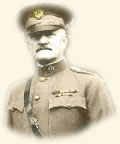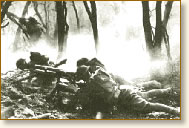America in the Great War
The United States was unprepared for its entrance into the First World War. In April 1917, the American Army numbered only 300,000 including all the National Guard units that could be federalized for national service. The Army's arsenal of war supplies was non-existent and its incursion into Mexico the previous year pointed out the severe deficiencies in its military structure including training, organization, and supply.
When the European continent erupted in conflict in 1914, President Wilson declared
America's neutrality. He proposed an even-handed approach towards all the
belligerents that was to be maintained in both "thought
 |
A woman worker in a
munitions plant, 1918 |
and deed." The
President steadfastly maintained his hope of a peaceful solution to the conflict
despite the protestations of those (including former president Roosevelt) convinced
that events in Europe would inevitably draw America into the war. In 1916, Wilson
campaigned for reelection on a peace platform with the slogan "He kept us out
of war."
Events in Europe altered Wilson's outlook. Germany's campaign of unrestricted submarine warfare, the loss of American lives on the high seas, the sinking
of the Lusitania and
other ships and the prospect that Germany would not change her policies compelled
a reluctant Wilson to ask Congress for a declaration of war in April 1917.
Things were not going well for the Allies at the time. Russia erupted in
revolution
in March 1917 and would soon be out of the war altogether. Italy suffered a
major defeat when the Austrians captured over 275,000 soldiers in the Battle
of Caporetto
forcing the British and French to divert troops from the Western Front to keep
Italy in the war. The situation remained stagnate on the Western Front - and
worse. Mutiny spread throughout the French Army raising the fear that her armed
forces may collapse from within. In Britain, the German submarine campaign
was so successful that predictions foresaw Britain's collapse within a matter
of
months.
The Allies looked to America for salvation with the expectation that the industrial
strength of the United States would replenish the supply of war material necessary
for victory. In most cases
these expectations were unrealistic. For example, the US built no more than
800 airplanes prior to 1917, and yet the French premier called on the US to
immediately produce 2,000 airplanes per
 |
General
"Black Jack" Pershing |
month.
Additionally, the Allies expected the United States to provide an unlimited
supply of manpower they could absorb into their beleaguered divisions.
Wilson selected General John J. Pershing (called "Black Jack" after he commanded
the famous 10th cavalry in he 1890s) to head the American Expeditionary Force.
Pershing left for Europe with a mandate from Wilson to cooperate with Allied
forces under the following proviso - "that the forces of the United States are
a separate and distinct component of the combined forces the identity of which
must be preserved." In other words, there would be no wholesale melding of American
soldiers into the British and French armies as the Allied commanders hoped. The
United States would fight under its own flag and its own leadership. This proved
to be a bone of contention among the Allies for the rest of the war.
America's buildup was slow - Pershing called for a million men, Congress replied it could muster 420,000 by spring 1918. The anticipated cornucopia of military supplies from America never materilaized. For the most part the doughboys fought with equipment supplied by the Allies (including the distinctive helmet provided by the British). American troops saw their first action in May 1918 in fighting alone the Marne River. In September,
 |
A gun crew in action during the
Battle of Belleau Wood,
June 1918 |
Pershing ordered an all-out attack in the Saint-Mihiel area of Eastern France. Casualties were high but the attack forced a German retreat that (combined with other Allied offensives along the Western Front) put the entire German army on the run. In early October, the Americans pushed through the Argonne Forest. The German High Command began to crack in the face of the persistent Allied onslaught. General Ludendorff was forced to resign and flee to Sweden, mutiny reared its ugly head among the Kaiser's naval units, and the Kaiser himself abdicated on November 9. On November 11, Germany signed an armistice ending the war.
Pershing had thrown almost 1.2 million Americans into the battle. Casualties numbered 117,000. With the war over, Americans wished to forget Europe's troubles and return to "the good old days." Congress rejected Wilson's call for participation in the League of Nations. The nation turned inward again. This complacency remained unchallenged until Hitler's grab for European domination some 20 years later.
References:
Ions, Edmund, Woodrow Wilson - The Politics of Peace and War (1977); Kennedy, David, M., Over Here: The First World War and American Society (1980).
How To Cite This Article:
"America in the Great War," EyeWitness to History, www.eyewitnesstohistory.com (2000).
|






